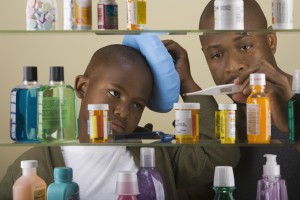Strep throat1 is a common type of a sore throat in children, but it’s not very common in adults. Healthcare professionals can do a quick test to determine if a sore throat is strep throat. If so, antibiotics can help you feel better faster and prevent spreading it to others. Jay Harold wrote this post, “Strep Throat: 6 Serious Complications & Relief,” that addresses a disease that affects as many as 616 million people2 worldwide each year. The Centers for Disease Control and Prevention (CDC) estimates that there are several million cases of infection with Group A strep bacteria in the United States each year.
Many things can cause that unpleasant, scratchy, and sometimes painful condition known as a sore throat. Viruses, bacteria, allergens, environmental irritants (such as cigarette smoke), and chronic postnasal drip can all cause a sore throat. While many sore throats will get better without treatment, some throat infections—including strep throat—may need antibiotic treatment.
How You Get Strep Throat
Strep throat is an infection in the throat and tonsils caused by group A Streptococcus bacteria (called “group A strep”). Group A strep bacteria can also live in a person’s nose and throat without causing illness. The bacteria spread through contact with droplets after an infected person coughs or sneezes. If you touch your mouth, nose, or eyes after touching something with these droplets on it, you may become ill. If you drink from the same glass or eat from the same plate as a sick person, you could also become ill. It is also possible to get strep throat from touching sores on the skin caused by group A strep.
Group A Streptococcus (group A strep) is a bacterium3 that can cause many different infections, including strep throat, scarlet fever, impetigo, and others. The bacteria live in the nose and throat. When someone who is infected coughs or sneezes, the bacteria travel in small droplets of water called respiratory droplets. One of the ways you can get sick is if you breathe in those droplets or if you touch something that has the droplets on it and then touch your mouth, nose, or eyes.
A sore throat that starts quickly, pain with swallowing, and fever are some of the common signs and symptoms of strep throat.
The most common symptoms of strep throat include:
- A sore throat usually starts quickly and can cause pain when swallowing
- A Fever
- Red and swollen tonsils, sometimes with white patches or streaks of pus

- Tiny, red spots (petechiae) on the roof of the mouth (the soft or hard palate)
- Swollen lymph nodes in the front of the neck
Other symptoms may include a headache, stomach pain, nausea, or vomiting. Someone with strep throat may also have a rash known as scarlet fever (also called scarlatina).
Strep throat symptoms typically do not include:
- A cough
- A runny nose
- Hoarseness (changes in your voice that make it sound breathy, raspy, or strained)
- Conjunctivitis (also called pink eye4)
These symptoms suggest that a virus is the cause of the illness.
A Simple Test Gives Fast Results
No one can diagnose strep throat just by looking at your throat. Instead, healthcare professionals use two tests to see if group A strep bacteria are causing a sore throat. A “rapid strep test” involves swabbing your throat and gives results quickly. If the test is positive, your healthcare professional can prescribe antibiotics. If the test is negative, but your healthcare professional still strongly suspects strep throat, then they order a throat culture. A throat culture involves sending a throat swab to a lab to see if bacteria grow from the sample. For that reason, a throat culture takes more time to get results.
Sore Throat Relief5

- Try hot tea with lemon or some hot soup.
- Keep your throat moist with lozenges or hard candies.
- Gargle with warm salt water or use ice chips.
- Cold liquids or popsicles can numb the pain. Throat sprays and over-the-counter pain relievers can help, too.
- Use a humidifier or vaporizer, especially when sleeping, to keep air from getting too dry.
- If a sore throat persists for several days, contact a healthcare professional.
Antibiotics Get You Well Fast
Test results help your healthcare professional decide if you need antibiotics, which can:
- Decrease the length of time you’re sick
- Reduce your symptoms
- Help prevent the spread of infection to others
- Prevent more serious complications, such as tonsil and sinus infections, and acute rheumatic fever (a rare inflammatory disease that can affect the heart, joints, skin, and brain)
You should start feeling better in just a day or two after starting antibiotics. Call your healthcare professional if you don’t feel better after taking antibiotics for 48 hours. People with strep throat should stay home from work, school, or daycare until they no longer have a fever and have taken antibiotics for at least 24 hours, so they don’t spread the infection to others.
Take the prescription exactly as your healthcare professional tells you. Don’t stop taking the medicine, even if you feel better unless your healthcare professional tells you to stop taking it.
Serious Complications Are Not Common but Can Happen
Complications can occur after a strep throat infection. This can happen if the bacteria spread to other parts of the body. Complications can include:

- Abscesses (pockets of pus) around the tonsils
- Swollen lymph nodes in the neck
- Sinus infections
- Ear infections
- Rheumatic fever6 (a heart disease)
- Post-streptococcal glomerulonephritis7 (a kidney disease).
More Prevention Tips: Wash Those Hands
The best way to keep from getting strep throat is to wash your hands often. Also, avoid sharing eating utensils, like forks or cups. Anyone with a sore throat should wash their hands often and cover their mouth when coughing and sneezing. There is no vaccine to prevent strep throat.
Jay Harold hopes you enjoyed this post, “Strep Throat: 6 Serious Complications & Relief”. Please remember that Strep throat is a bacterial infection that can cause you to have a sore, scratchy throat. The infection mostly affects children ages 5 to 15, but anyone can get it.
Please Share it and read more about Jay Harold here. Please take this advice from Muhammad Ali and give back to others. “Service to others is the rent you pay for your room here on earth.”
Bibliography
- https://www.cdc.gov/features/strepthroat/index.html
- https://www.everydayhealth.com/strep-throat/
- https://www.cdc.gov/groupAstrep/
- https://www.cdc.gov/features/conjunctivitis/
- https://newsinhealth.nih.gov/2013/03/soothing-sore-throat
- https://www.cdc.gov/groupastrep/diseases-public/rheumatic-fever.html
- https://medlineplus.gov/ency/article/000503.htm




